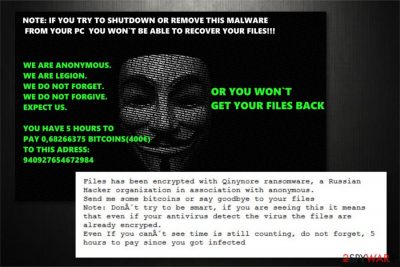Qinynore ransomware (Decryption Methods Included) - Virus Removal Guide
Qinynore virus Removal Guide
What is Qinynore ransomware?
Qinynore ransomware is a file-encrypting virus which originates from the infamous Hidden Tear virus

Qinynore is a ransomware which encrypts all information stored on the targeted computer and demands to pay a ransom of €400. Experts note that this virus is considered to be a new variant of the infamous Hidden Tear ransomware. After file encryption, victims receive YOU_MUST_READ_ME.rtf file as a ransom note, and all encoded documents contain .anonymous extension at the end of the file-name. Additionally, the desktop wallpaper is changed to the picture named LOL.jpg. Hackers claim that people have 5 hours to make the transaction. Otherwise, the files will be lost permanently.
| Name | Qinynore |
|---|---|
| Type | Ransomware |
| Precursor | Hidden Tear |
| Danger level | High. Makes data unusable |
| Extension | .Anonymous |
| Ransom note | YOU_MUST_READ_ME.rtf |
| Amount of the ransom | €400 in BTC |
| Distribution | Criminals send spam emails with infected attachments to spread the crypto-malware |
| Removal | FortectIntego can help you fix virus damage after Qinynore elimination |
After Qinynore virus infiltrates the system, it starts encoding data. Later, the desktop wallpaper is changed, and victims see the following text on the screen:
WE ARE ANONYMOUS.
WE ARE LEGION.
WE DO NOT FORGET.
WE DO NOT FORGIVE.
EXPECT US.
Furthermore, they are asked to pay a specific amount of money as a ransom to receive Qinynore decryption software. Criminals give 5 hours for people to complete the transaction or the information will be deleted. However, our experts warn that hackers should never be trusted[1].

Usually, once the payment is made they either demand to pay more or never provide the decryption key. Likewise, following the orders of the cyber attackers is not the wisest decision. If you notice files with .anonymous extension[2], you should run a full system scan with a robust antivirus immediately to remove Qinynore ransomware.
In case you are unable to start Qinynore removal, try booting your computer into Safe Mode first. Instructions showing how to do that are provided below. Additionally, they include decryption methods that may help you recover files with .anonymous extension. For automatic virus damage fix, we suggest using FortectIntego.
Spam email attachments might carry a payload of the ransomware
According to the experts, the main ransomware distribution source is spam emails. Note that users fail to identify attempts to infect their computers as electronic letters impersonate invoices or shopping receipts from well-known companies. Unfortunately, the innocent-looking attachment might hold the payload of the ransomware and execute it once clicked.
Therefore, you should take precautionary measures and closely monitor your inbox — never open spam emails or their attachments. Be sure to notice the following details which indicate that the email might be malicious:
- The email address includes random and unnecessary characters;
- You are urged to click on the link or file as soon as possible;
- The message contains grammar or spelling mistakes.
Steps to get rid of Qinynore ransomware virus
If your PC is infected with Qinynore ransomware, you should first reboot your computer into Safe Mode. This step is crucial as the virus will block the installation of the antivirus otherwise. Those who are not aware of how to enter Safe Mode can use the guide attached below.
Then to start Qinynore removal, you must download and install a reliable antivirus program. Experts[3] suggest using FortectIntego, SpyHunter 5Combo Cleaner, or Malwarebytes to protect your system. You can remove Qinynore virus by running a full system scan. Afterward, check the guidelines below to learn how to recover encoded data.
Getting rid of Qinynore virus. Follow these steps
Manual removal using Safe Mode
First, you should disable the ransomware by booting your computer into Safe Mode with Networking:
Important! →
Manual removal guide might be too complicated for regular computer users. It requires advanced IT knowledge to be performed correctly (if vital system files are removed or damaged, it might result in full Windows compromise), and it also might take hours to complete. Therefore, we highly advise using the automatic method provided above instead.
Step 1. Access Safe Mode with Networking
Manual malware removal should be best performed in the Safe Mode environment.
Windows 7 / Vista / XP
- Click Start > Shutdown > Restart > OK.
- When your computer becomes active, start pressing F8 button (if that does not work, try F2, F12, Del, etc. – it all depends on your motherboard model) multiple times until you see the Advanced Boot Options window.
- Select Safe Mode with Networking from the list.

Windows 10 / Windows 8
- Right-click on Start button and select Settings.

- Scroll down to pick Update & Security.

- On the left side of the window, pick Recovery.
- Now scroll down to find Advanced Startup section.
- Click Restart now.

- Select Troubleshoot.

- Go to Advanced options.

- Select Startup Settings.

- Press Restart.
- Now press 5 or click 5) Enable Safe Mode with Networking.

Step 2. Shut down suspicious processes
Windows Task Manager is a useful tool that shows all the processes running in the background. If malware is running a process, you need to shut it down:
- Press Ctrl + Shift + Esc on your keyboard to open Windows Task Manager.
- Click on More details.

- Scroll down to Background processes section, and look for anything suspicious.
- Right-click and select Open file location.

- Go back to the process, right-click and pick End Task.

- Delete the contents of the malicious folder.
Step 3. Check program Startup
- Press Ctrl + Shift + Esc on your keyboard to open Windows Task Manager.
- Go to Startup tab.
- Right-click on the suspicious program and pick Disable.

Step 4. Delete virus files
Malware-related files can be found in various places within your computer. Here are instructions that could help you find them:
- Type in Disk Cleanup in Windows search and press Enter.

- Select the drive you want to clean (C: is your main drive by default and is likely to be the one that has malicious files in).
- Scroll through the Files to delete list and select the following:
Temporary Internet Files
Downloads
Recycle Bin
Temporary files - Pick Clean up system files.

- You can also look for other malicious files hidden in the following folders (type these entries in Windows Search and press Enter):
%AppData%
%LocalAppData%
%ProgramData%
%WinDir%
After you are finished, reboot the PC in normal mode.
Remove Qinynore using System Restore
-
Step 1: Reboot your computer to Safe Mode with Command Prompt
Windows 7 / Vista / XP- Click Start → Shutdown → Restart → OK.
- When your computer becomes active, start pressing F8 multiple times until you see the Advanced Boot Options window.
-
Select Command Prompt from the list

Windows 10 / Windows 8- Press the Power button at the Windows login screen. Now press and hold Shift, which is on your keyboard, and click Restart..
- Now select Troubleshoot → Advanced options → Startup Settings and finally press Restart.
-
Once your computer becomes active, select Enable Safe Mode with Command Prompt in Startup Settings window.

-
Step 2: Restore your system files and settings
-
Once the Command Prompt window shows up, enter cd restore and click Enter.

-
Now type rstrui.exe and press Enter again..

-
When a new window shows up, click Next and select your restore point that is prior the infiltration of Qinynore. After doing that, click Next.


-
Now click Yes to start system restore.

-
Once the Command Prompt window shows up, enter cd restore and click Enter.
Bonus: Recover your data
Guide which is presented above is supposed to help you remove Qinynore from your computer. To recover your encrypted files, we recommend using a detailed guide prepared by 2-spyware.com security experts.If your files are encrypted by Qinynore, you can use several methods to restore them:
Get Data Recovery Pro for help
According to the experts, users might try installing this professional tool to help them retrieve encrypted data. Keep in mind that this software is also useful if you have accidentally deleted important files by yourself.
- Download Data Recovery Pro;
- Follow the steps of Data Recovery Setup and install the program on your computer;
- Launch it and scan your computer for files encrypted by Qinynore ransomware;
- Restore them.
Try using Windows Previous Versions feature
You can take advantage of the inbuilt feature which allows you travelling back in time to recover damaged data. For more details, read the instructions below. Although, this method requires System Restore function to be enabled before ransomware attack.
- Find an encrypted file you need to restore and right-click on it;
- Select “Properties” and go to “Previous versions” tab;
- Here, check each of available copies of the file in “Folder versions”. You should select the version you want to recover and click “Restore”.
Install ShadowExplorer to recover files
You can download ShadowExplorer software if the ransomware hasn't deleted Shadow Volume Copies from your system. More information is provided below:
- Download Shadow Explorer (http://shadowexplorer.com/);
- Follow a Shadow Explorer Setup Wizard and install this application on your computer;
- Launch the program and go through the drop down menu on the top left corner to select the disk of your encrypted data. Check what folders are there;
- Right-click on the folder you want to restore and select “Export”. You can also select where you want it to be stored.
Qinynore decryption software
Even though official Qinynore decryptor is still under development, you can try using original Hidden Tear decryptors:
Finally, you should always think about the protection of crypto-ransomwares. In order to protect your computer from Qinynore and other ransomwares, use a reputable anti-spyware, such as FortectIntego, SpyHunter 5Combo Cleaner or Malwarebytes
How to prevent from getting ransomware
Access your website securely from any location
When you work on the domain, site, blog, or different project that requires constant management, content creation, or coding, you may need to connect to the server and content management service more often. The best solution for creating a tighter network could be a dedicated/fixed IP address.
If you make your IP address static and set to your device, you can connect to the CMS from any location and do not create any additional issues for the server or network manager that needs to monitor connections and activities. VPN software providers like Private Internet Access can help you with such settings and offer the option to control the online reputation and manage projects easily from any part of the world.
Recover files after data-affecting malware attacks
While much of the data can be accidentally deleted due to various reasons, malware is one of the main culprits that can cause loss of pictures, documents, videos, and other important files. More serious malware infections lead to significant data loss when your documents, system files, and images get encrypted. In particular, ransomware is is a type of malware that focuses on such functions, so your files become useless without an ability to access them.
Even though there is little to no possibility to recover after file-locking threats, some applications have features for data recovery in the system. In some cases, Data Recovery Pro can also help to recover at least some portion of your data after data-locking virus infection or general cyber infection.
- ^ Lee Mathews. Why You Should Never Pay A Ransomware Ransom. Forbes. Global Media Company.
- ^ Brady Gavin. What Is A File Extension?. How-To Geek. We Explain Technology.
- ^ NoVirus. NoVirus. Security and Spyware News.





















